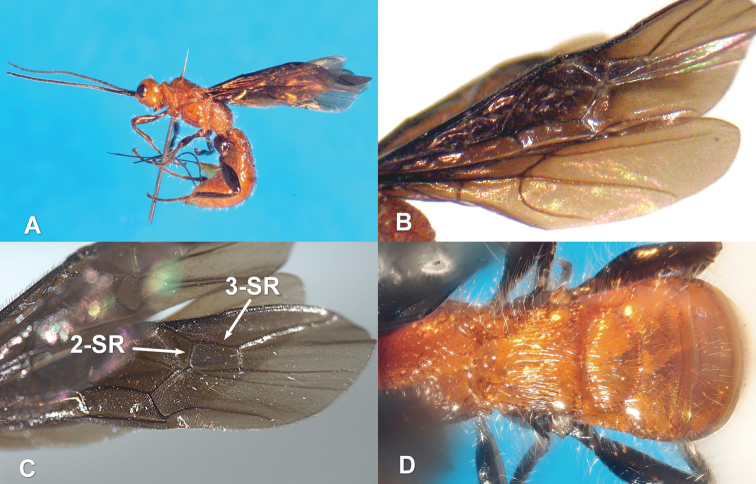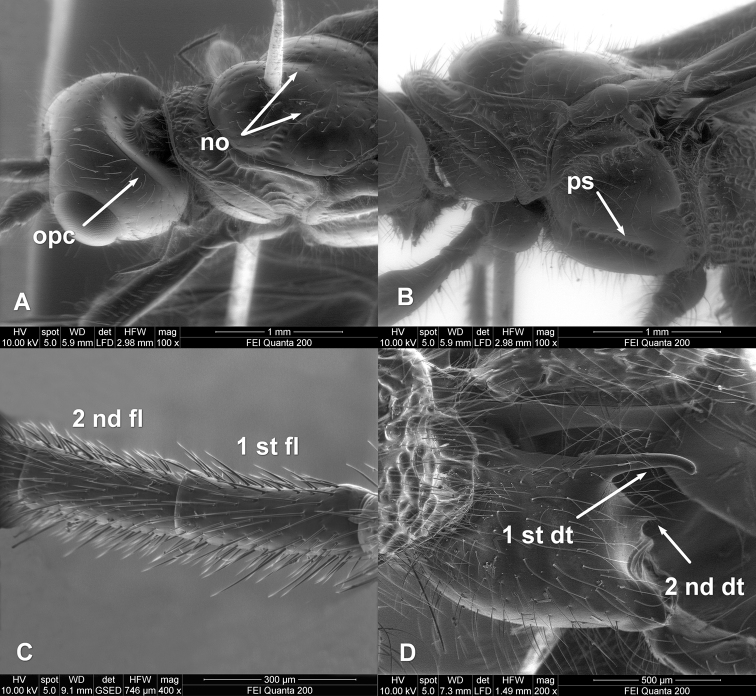Abstract Abstract
The finding of Zombrus bicolor (Enderlein) (Hymenoptera: Braconidae: Doryctinae) in a Tuscan vineyard of the Siena province (Italy) represents the first record of this species in western Europe. A female was captured in summer 2009 with a malaise trap located in an organic vineyard. Until this finding, the species was recorded only in the Oriental regions of continental China, Taiwan, Korea and Japan and, very recently, in the eastern and southern parts of the Palaearctic region.
Keywords: Vineyard, new finding, wood borer parasitoid, exotic species, Anoplophora chinensis
Introduction
A single female of Zombrus bicolor (Enderlein) (Hymenoptera: Braconidae: Doryctinae) was collected in June 2009 in a malaise trap located in a vineyard (cv Sangiovese) of an organic farm in the Montalcino district (Siena-Tuscany-Italy, 43°05.21N, 11°28.51E). The trap was installed at ca 180 m above sea level in a typical rural Tuscan landscape, with vineyards included in rolling, gentle hills surrounded by cultivated grassland areas, woods and strips of shrubs, and wild bushes of deciduous trees. Until the current finding, Zombrus bicolor had only been reported as an Eastern Palaearctic and Oriental species, based on the description of specimens collected in Taiwan, China, Mongolia, Japan, Korea and, very recently, in Kyrgyzstan and in the European part of Russia (Astrakhan province) (Enderlein 1912; Fahringer 1929; Fischer 1980; Chou 1981; Papp 2003, Belokobylskij and Maetô 2009; Belokobylskij and Samartsev 2011).
The type specimens of Zombrus bicolor are two males stored in the collection of the Museum of the Zoology Institute in Warsaw (Poland). These males were collected by H. Sauter in 1907 in Takao (Formosa), the old name of the current city of Kaohsiung in south-western Taiwan, and subsequently described by Enderlein (1912).
Zombrus bicolor (Fig. 1A) belongs to the subtribe Odontobraconina of the tribe Holcobraconini, a monophyletic group including six genera and currently divided in the three subtribes Holcobraconina, Odontobraconina and Ivondroviina, (Belokobylskij 1992). The morphological features that characterize the tribe, the genus Zombrus and the species Zombrus bicolor are well described in Belokobylskij and Samartsev (2011).
Figure 1.
Zombrus bicolor female: A body lateral view B fore and hind wings C detail on the fore wing D abdominal terga 1-3 dorsal view.
According to these authors, the typical morphological features of Zombrus bicolor, which distinguish this species from the other Palaearctic species of Zombrus, are the completely dark fore wings (Fig. 1B), the body covered with long and dense setae (Fig. 1 D, Fig. 2 A, B, D) and the presence of the occipital carina dorsally and, partly, laterally (Fig. 2A).
Figure 2.
Zombrus bicolor female, SEM micrographs details on: A head and mesoscutum B mesopleuron C first and second flagellomeres D hind coxa. Abbreviations: 2-SR and 3-SR sectio radii veins of fore wing opc = occipital carina no = notauli ps = precoxal sulcus 1st and 2nd fl = first and second flagellomeres 1st and 2nd dt = first and second dorsal teeth of hind coxa. Morphological terminology is used according to van Achterberg (1993).
All the features of the specimen we collected in Italy match well with those reported by Belokobylskij and Samartsev (2011), with exception of the notauli which are not complete but reduced posteriorly on the mesoscutum (Fig. 2A).
Our finding could represent one of the many cases of accidental introduction of exotic insects that have occurred in Italy in the last decades. At European level as well, the accidental introduction of new insect species from their original areas has become more and more frequent and alarming. Intensification of plant trade with geographically distant commercial partners and global warming, that allows aliens to establish successfully in new ecosystems, are considered the main causes of the occurrence of invasive species.
As an important crossroad in the Mediterranean basin, Italy seems particularly suitable to the introduction and settlement of alien species, also because its landmass extends over a wide range of latitudes climatically suitable to harbour subtropical species in the South and insects coming from temperate and continental zones in the northern and central regions of the peninsula.
It has been estimated that about 200 exotic species have been introduced and established in Italy since 1970 (Longo 2009), the vast majority of whom are insect pests.
Importantly, our finding concerns not a pest but a parasitoid, which in this case could have followed his victim/s in the transfer from one continent to another. This is permissible every time that the natural enemy is a cryptic species, such as an endoparasitoid, or an ectoparasitoid living in concealed galleries excavated by larvae of wood boring insects.
Zombrus bicolor is known as a solitary, larval parasitoid of many wood boring beetles (Yu et al. 2010; Belokobylskij and Samartsev 2011), including Anoplophora chinensis (Forster) (Coleoptera: Cerambycidae) (Smith et al. 2007). This wood borer was first detected in 2000 in northern Italy, in the surroundings of Milan and rapidly became a serious threat to deciduous trees in urban areas and natural forests throughout northern and central Italy. Anoplophora glabribennis was also found in the same area in 2007 (Maspero et al. 2007).These species are major pests of many deciduous trees and fruit plants in their native Asian countries (Hu et al. 2009), are considered quarantine pests for the European Union according to the Directive 2000/29/EC and are subjected to monitoring and eradication programs (Herard et al. 2009).
Though data are not available at the moment on the presence of Anoplophora chinensis in the areas where we collected Zombrus bicolor, we cannot exclude that the braconid, in its movement to West Europe, had been carried by these or other specific hidden hosts.
Acknowledgments
We are grateful to Dr. S.A. Belokobylskij (Zoological Institute, Russian Academy of Sciences, St Petersburg) for his useful suggestions.
References
- Achterberg C van. (1993) Illustrated key to the subfamilies of the Braconidae (Hymenoptera: Ichneumonoidea). Zoologische verhandelingen 283: 1-189 [Google Scholar]
- Belokobylskij SA. (1992) On the classification and phylogeny of the braconide wasps of subfamilies Doryctinae and Exothecinae (Hymenoptera, Braconidae). Part I. On the classification, 1. Entomologicheskoye Obozreniye 71 (4): 900-928 [Google Scholar]
- Belokobylskij SA, Maetô K. (2009) Doryctinae (Hymenoptera, Braconidae) of Japan. (Fauna mundi. Vol 1) Warszawa: Warshawska Drukarnia Naukova. 806 p.
- Belokobylskij SA, Samartsev KG. (2011) First record of the tribe Holcobraconini and the genus Zombrus Marshall, 1897 (Hymenoptera: Braconidae: Doryctinae) in Europe. Zoosystematica Rossica 20 (2): 310-318 [Google Scholar]
- Chou L. (1981) A preliminary list of Braconidae (Hymenoptera) of Taiwan. Journal agricultural Research China 30 (1): 71-88 [Google Scholar]
- Enderlein G. (1912) Zur Kenntnis der Spathiinen und einiger verwandter Gruppen. Archiv für Naturgeschichte (A), 78 (2): 1-37 [Google Scholar]
- Fahringer J. (1929) Beiträge zur Kenntnis der Braconiden-Fauna Chinas. Entomologisk Tidskrift 50: 82-88 [Google Scholar]
- Fischer M. (1980) Taxonomische Untersuchungen über Doryctinae aus der Odontobracon- Verwandtschaft (Hymenoptera, Braconidae). Annales Naturhistorische Museum Wien 83: 547-572 [Google Scholar]
- Herard F, Maspero M, Ramualde N, Jucker C, Colombo M, Ciampitti M, Cavagna B. (2009) Anoplophora glabripennis infestation (col.: cerambycidae) in Italy. Bullettin OEPP/EPPO 39: 146-152 [Google Scholar]
- Hu J, Angeli S, Schuetz S, Luo Y, Hajek AE. (2009) Ecology and management of exotic and endemic Asian longhorned beetle Anoplophora glabripennis. Agricultural and Forest Entomology 11 (4): 359-375 doi: 10.1111/j.1461-9563.2009.00443.x [Google Scholar]
- Longo S. (2009) Fitofagi esotici e invasioni biologiche negli ecosistemi forestali. Atti Accademia Nazionale Italiana di Entomologia, Anno LVII: 69–77.
- Maspero M, Jucker C, Colombo M. (2007) First record of Anoplophora glabripennis (Motschulsky) (Coleoptera Cerambycidae Lamiinae Lamiini) in Italy. Bollettino di Zoologia agraria e di Bachicoltura Ser II, 39 (2): 161-164 [Google Scholar]
- Papp J. (2003) Braconidae (Hymenoptera) from Korea, XXI. Species of fifteen Subfamilies. Acta Zoologica Academiae Scientiarum Hungaricae 49 (2): 115-152 [Google Scholar]
- Smith MT, Fuester RW, Tropp JM, Aparicio EM, Tatman D, Wildonger JA. (2007) Native natural enemies of native woodborers potential as biological control agents for the Asian longhorned beetle. USDA Interagency Research Forum - GTR-NRS-P- 28: 66-70 [Google Scholar]
- Yu D, Barak AV, Jiao Y, Chen Z, Zhang G, Chen Z, Kang L, Yang W. (2010) Sulfuryl Fluoride as a Quarantine Treatment for Chlorophorus annularis (Coleoptera: Cerambycidae) in Chinese Bamboo Poles. Journal of Economic Entomology 103 (2): 277-283 doi: 10.1603/EC09292 [DOI] [PubMed] [Google Scholar]




